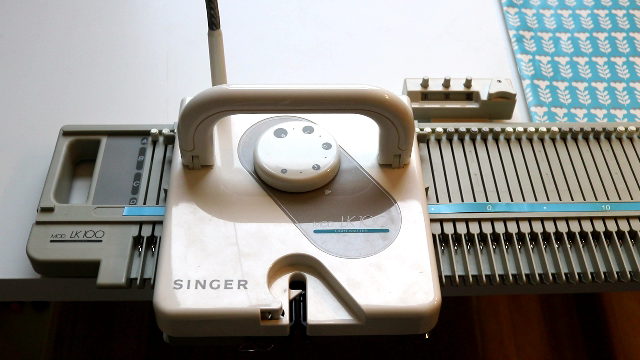How to choose your first knitting machine
/So you are looking into buying a knitting machine, and totally clueless and confused by different choices. This article is going to clarify different choices and help you decide on the best knitting machine for beginners.
Why machine knitting?
Hand knitting with a pair of double point needle or circular needle is fun and relaxing, but it takes so much time, especially if you are a new mother or have a busy career. Or maybe you have too many design ideas in your head and not enough time to knit it out. Yes, a knitting machine will greatly speed up the projects.
Maybe your hand gets so tired or hurt from knitting for a long time, or your eyesight is bothering you with all the tiny stitches. Maybe you just want to de-stash quickly and create big projects like blankets in a shorter time. These are all common reasons people turn to machine knitting.
Machine knitting myth
1. A knitting machine will do all the work for you. It is cheating compared to hand knitting.
First, there is a learning curve to operate the machine. Even with the most advanced computer-aided knitting machine, you still need to input the design and learn to knit different stitches, and takes time finishing pieces. It is not just push a button and everything will be done magically. You will not call the person using a sewing machine cheating, so why is it different from the knitting machine?
2. Knitting machine is hard to find and difficult to learn
Most knitting machines are second hands or pre-owned. It does take some research to find the right one and need to clean and maintain the machine once in a while. It is the same as all machines, just like maintaining a sewing machine. Usually, it is just applying oil and changing out the sponge retaining bar.
It seems difficult to learn because of the lack of resource. Now with the online forum, group, classes and YouTube videos, information is much easier to obtain. All the flatbed Japanese style machine are similar to operate. People are also finding creative ways to solve knitting problems. There is no limit to what you can do with your machine.
Basic types of the flat-bed domestic knitting machine
We are talking about the Japanese style, flat-bed domestic knitting machine, instead of circular knitting machine or industrial knitting machine. We can basically categorize them by brands, gauge, and attachments.
Brands
The most popular 2 brands are Brother/Knit King, and Singer/ Studio /Silver Reed. The name changes over time or in different locations. They operate slightly differently and have different names for the same function or buttons/lever. Some prefer Brother and some prefer Singer. It is just personal preference. Brother accessories will not fit Singer and vice versa.
There is also a new brand that is the clone of Brother brand called Artisan or Taitexma (allbrands.com). Because they are new, the price will be higher. I heard some fashion school use them in a classroom. Some people question the quality because it is made in China. The advantage is that they are newly manufactured, so the customer service and repair should be easier.
Other popular brands include Passap and Toyota. They have their own system and operate slightly different from Brother and Singer.
No matter which brand you choose, if you spend time learning well, it could be your best friend. If the machine just sits there collecting dust, no matter how expensive, it is still not the right machine for you.
Gauge
Metal bed knitting machine can be categorized by the gauge: fine, standard, and bulky. Fine and mid-gauge metal bed machines are harder to find now. Most plastic bed machines are the mid-gauge to the bulky machine. Plastic bed machine is also called hobby machine because it is lightweight and less complicated. Even though it is called the hobby machine, I find them very reliable and easy to learn for beginners.
Here is the basic of the different gauge in mm between needles, and their matching yarn thickness:
Standard: 4.5 mm - finger, sock yarn, baby, and sports weight yarn
Midgauge: 6.5 - 7.5 mm - all the yarn above plus DK weight. Maybe light worsted weight.
Bulky: 9 mm - from sports weight, DK weight to worsted weight. Sock yarn or finger weight might be knitted a little too loosely.
Depending on what kind of project you want to knit, pick the gauge accordingly. It is easy to see that the mid-gauge and bulky machine can handle the widest range of the hand knitting yarns from sports to worsted.
Attachments, accessories, and patterning
A ribber is a flatbed attachment to make ribbing and circular knitting. A punch card machine makes the pattern with a punch card device. An electronic machine can input pattern with a disk or computer connection, and a garter carriage is a Brother device to knit purl stitches electronically. There are a lot of choices of add-on or patterning device you should consider.
Most plastic bed machine doesn't have a patterning device or ribber attachment. Most later model metal bed machine has some types of patterning device such as punchcard, knit leader, or an electronic one. You have to know if what is important function to you when you choose a machine.
My suggestion for beginner
The first category I recommend for beginners is the plastic bed mid or bulky machine. For example, Singer / Studio / Silver Reed LK100, LK140, LK150, Brother KX350, KX390, KX395, KX400.
The advantage: It is usually cheaper to buy, very reliable and don't need a lot of adjustment, takes a variety of yarn thickness similar to hand knitting yarn, lightweight and portable, less intimidating than the metal bed machine, fewer accessories means less complicated and easier to learn.
The second category I recommend it the metal bed standard or bulky machine punchcard machine. Does not matter if it is Brother or Singer/Studio/Silver Reed. Even though they are most likely second hand machines, but still easily available, meaning it is easy to find parts, tutorials, patterns and add-on accessories.
Punchcard patterning opens up the potential to punch your own design, yet still not requiring electric power. The issue with electronic or computer machine is that it will be outdated eventually and the parts might need service by professionals in the future.
Conclusion
It really comes down to what suits your current need or the projects you intend to make. Most people I know end up having several machines. Many still treasure the plastic bed hobby machine even though they have a fancy computerized machine.
If you are looking for your first machine to try, the plastic machine is a good choice. If you have access to a cheap metal bed machine from the local yard sale or eBay online, it is a solid choice too. Just remember a metal bed machine is very heavy and takes a lot of space. You have to think about storage too when not in use.
Hope this article helps you make a better decision on choosing your first knitting machine. See the videos below for my knitting machine collections. If you enjoy it, please consider subscribing to our channel: http://bit.ly/creativetien













